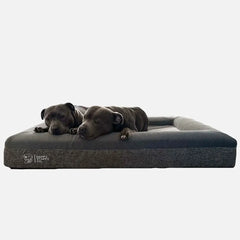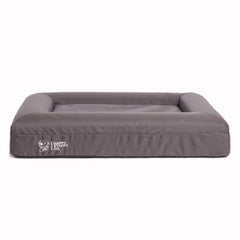
Picture your Staffy curled up, dreaming peacefully on a bed that cradles every joint and muscle. It’s more than just adorable—it’s a sign of deep comfort and well-being. Now imagine the opposite: a restless pup, shifting constantly, struggling to find the right position. Often, the difference lies in what they’re sleeping on.
So, what's the difference between a standard dog bed and an orthopedic one? A standard bed provides basic comfort, but an orthopedic bed offers targeted joint support, pressure relief, and long-term health benefits—especially for senior or active dogs.
Choosing the right dog bed isn’t just about aesthetics or keeping your furniture fur-free. It’s about ensuring your dog’s body is properly supported during their most restful hours. It’s about prevention, recovery, comfort, and love—all rolled into one place they can call their own.
Key Takeaways
-
Standard dog beds offer basic comfort but tend to flatten quickly and lack long-term joint support.
-
Orthopedic dog beds provide targeted relief using high-density memory foam that supports the spine, hips, and joints.
-
Older dogs, large breeds, and pets with joint issues benefit the most from orthopedic beds for better rest and mobility.
-
While orthopedic beds cost more upfront, they last longer and can help reduce future vet bills by preventing strain.
-
Choosing the right bed depends on your dog’s age, health, and sleep habits, not just style or price.
What Is a Standard Dog Bed?
Materials and Structure
Standard dog beds are often made with basic materials like polyester stuffing, cotton batting, or low-density foam. The outer covers might be canvas, faux suede, or fleece, depending on the brand. These beds tend to prioritise initial softness and affordability over long-term support.
The structure of a standard bed typically lacks contouring. It might compress easily under your dog’s weight, which means the bed flattens over time and loses its ability to cushion properly.
Benefits of Standard Dog Beds
They're usually the budget-friendly choice and can be picked up from most pet stores without much fuss. If your dog is young, healthy, and has no existing joint concerns, a standard bed might do the trick for casual lounging.
They're also lightweight, easy to move around the house, and great for travel or crate use. Some dogs even prefer the simpler, less structured feel of a basic bed—especially if they enjoy sleeping on their backs or constantly change positions.
Limitations to Consider
But here's the catch—standard beds tend to wear out faster. The stuffing compresses, the support flattens, and before you know it, your dog is basically lying on the floor. This can lead to pressure on bony areas like elbows and hips, which over time can cause pain or even calluses.
For active breeds like Staffies or older dogs who need more joint care, standard beds simply don’t offer the long-term support required. They can even make existing issues worse over time by allowing poor alignment during sleep.
What Is an Orthopedic Dog Bed?
What Makes It “Orthopedic”?
Orthopedic dog beds are designed with medical-grade features to alleviate pressure on joints and muscles. The hallmark is high-density memory foam, which conforms to your dog’s shape and provides even weight distribution.
Many orthopedic beds also feature dual- or tri-layer construction. A top comfort layer cushions, while a firm bottom layer ensures overall support. Some include cooling gel for heat regulation, which is a plus for thick-coated breeds or warm climates.
Health Benefits
These beds aren't just comfy; they're therapeutic. Orthopedic beds can help dogs with arthritis, hip dysplasia, joint inflammation, or those recovering from surgery. By supporting proper alignment, they relieve pressure on hips, elbows, shoulders, and spine—letting your dog rest, recover, and feel good every time they lie down.
Other benefits include improved circulation, reduced stiffness, and better quality of sleep. For senior dogs, a good orthopedic bed can even extend mobility and reduce the frequency of medication.
Common Misconceptions
You don’t have to wait until your dog is old or in pain to upgrade. Orthopedic beds are a proactive investment in their health. Young Staffies, who are naturally muscular and energetic, can benefit from joint support to prevent long-term wear and tear.
Another myth is that orthopedic beds are only for large dogs. In reality, small breeds with long backs—like Dachshunds—can be just as prone to spinal issues and benefit greatly from these beds.
Orthopedic vs Standard Dog Bed: A Side-by-Side Comparison
|
Feature |
Standard Dog Bed |
Orthopedic Dog Bed |
|
Material |
Polyester, basic foam |
High-density memory foam |
|
Support |
Low to moderate |
High, joint-relieving |
|
Ideal For |
Healthy young dogs |
Seniors, injured, large breeds |
|
Price |
Lower upfront |
Higher, but longer lasting |
|
Durability |
Wears down fast |
Maintains shape over time |
|
Health Perks |
Basic comfort |
Supports joint and spine health |
Material Differences
Standard dog beds are typically made with basic materials such as polyester fill or low-density foam, which offer initial softness but flatten quickly. In contrast, orthopedic beds are built with high-density memory foam that contours to your dog’s body, offering better support and durability.
Levels of Support
The support a bed provides can dramatically affect your dog’s joint health. Standard beds offer low to moderate support, which may suffice for young, healthy dogs. Orthopedic beds provide high-level, joint-relieving support that aligns the spine and eases pressure on sensitive areas like hips and elbows.
Ideal Use Cases
Standard beds are best suited for puppies or younger dogs with no existing health issues. Orthopedic beds are ideal for seniors, large breeds, or dogs recovering from injury or surgery who need extra cushioning and support.
Price Consideration
While standard beds are generally cheaper upfront, they may wear out faster and need frequent replacement. Orthopedic beds come at a higher initial cost but provide long-term value due to their durability and health benefits.
Durability Over Time
Standard beds tend to lose their shape and support relatively quickly, especially with frequent use or heavy dogs. Orthopedic beds, especially those made with quality memory foam, are designed to maintain their structure and effectiveness for years.
Does Your Dog Need an Orthopedic Bed? How to Know
Signs Your Dog Might Need Extra Support
Watch your dog closely: Are they slow to rise after sleeping? Do they limp a little after a walk? Maybe they’re hesitant to jump on the couch like they used to. You might even notice them shifting positions a lot during sleep, trying to get comfortable.
Other signs include excessive licking of joints, pacing before lying down, or choosing to sleep on hard floors rather than their bed. These are subtle hints that their current setup might not be cutting it.
Age, Breed, and Size Considerations
Staffies, Labs, German Shepherds, Golden Retrievers, and other medium-to-large breeds are more prone to joint strain, simply because of their weight and energy levels. Senior dogs (usually 7 years and up) also lose joint fluid and muscle tone, making support even more important.
Overweight dogs, regardless of breed, need extra cushioning to relieve the added pressure on their joints. Orthopedic beds can help reduce long-term strain and improve their daily comfort.
What Vets and Experts Recommend
Veterinarians often recommend orthopedic beds for dogs recovering from surgery or those suffering from arthritis. The beds help promote healing and reduce inflammation by minimising joint pressure.
Some holistic vets even suggest pairing orthopedic beds with supplements like glucosamine and chondroitin to maximise joint support. It's all part of a broader care strategy to keep your dog healthy, mobile, and happy.
How to Choose the Right Dog Bed for Your Pet
Factors to Consider
When choosing a bed, think beyond the fluff. Consider your dog’s age, breed, weight, and health history. Does your Staffy sleep curled up like a croissant, or stretched out like a long baguette? The bed shape matters. Bolster-style beds are great for head support, while flat mats work better for sprawlers.
Also, think about where the bed will be placed. Beds near windows or draughty doors may need thicker, insulated padding. And if your dog sleeps in a crate, make sure the bed fits snugly and doesn't bunch up.
What to Look for in Quality Construction
Look for foam that is CertiPUR-US certified, meaning it’s made without harmful chemicals and is safe for your pet. Zippers should be hidden or reinforced, covers should be durable and chew-resistant, and the base should be slip-proof.
For dogs prone to accidents or drooling, a waterproof liner is a must. And if your dog sheds heavily, look for beds with hair-repellent fabrics or darker colours to hide the mess between washes.
Budget vs Long-Term Value
Yes, orthopedic beds come with a higher upfront cost. But consider this: a good orthopedic bed can last 5–7 years, while a cheap standard bed might need replacing every year. Over time, the orthopedic bed becomes the more cost-effective and health-positive choice. Not to mention, you'll likely save on vet bills by preventing or easing joint-related problems before they escalate.
Common Mistakes When Buying a Dog Bed (and How to Avoid Them)
-
Prioritise quality over aesthetics. Don’t be swayed by brand names or stylish designs—comfort, support, and durability should be your top priorities.
-
Choose the right size. Make sure the bed allows your dog to stretch out comfortably without their legs hanging off or their body curling unnaturally.
-
Opt for easy maintenance. Beds with removable, machine-washable covers make cleaning stress-free and extend the bed's lifespan.
-
Verify the foam quality. Look for trusted certifications like CertiPUR-US; many so-called “orthopedic” beds use low-grade materials that don’t offer real joint support.
-
Understand return policies. Some dogs may need time to adjust to a new bed, so flexible return or trial periods can be incredibly helpful.
-
Ease the transition. Help your pup love their new bed by placing it in a familiar spot and adding comforting items like a blanket or toy that smells like home.
Standard vs Orthopedic Dog Beds: Our Final Verdict
At the end of the day, it all comes down to your dog’s needs. If they’re young, healthy, and always on the go, a quality standard bed might suit them just fine.
But if they’re ageing, slowing down, or dealing with joint pain, they deserve more than just a place to lie down. They deserve a place to heal, relax, and recharge.
We created Happy Staffy Co. because we know that Staffies and strong breeds need products that match their energy and protect their joints. That’s why we always recommend investing in the right support—not just for today, but for their future.
Your best mate deserves the best rest. Let’s help them sleep like the legends they are.




